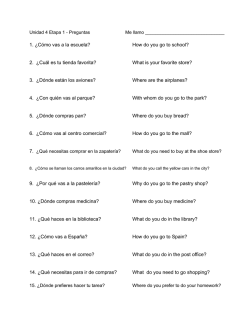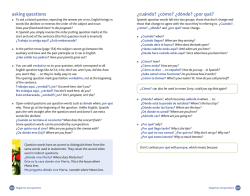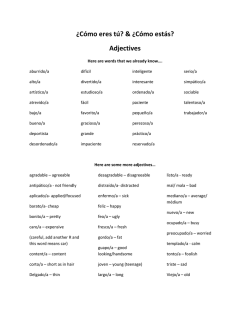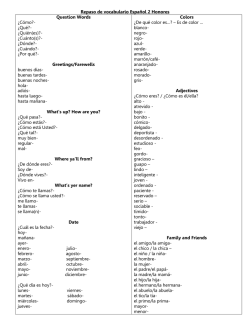
Sonrisas Level II Scope and Sequence 1. ¿Cómo se llama el/ella? 2
Sonrisas Level II Scope and Sequence Lesson Number/Name Communication Objective Performance Guidelines 1. ¿Cómo se llama el/ella? Student tells the name of another person. 2. En la escuela Student uses practical classroom phrases. 3. ¿Cómo vas a la escuela? Student uses the verb ir to provide information about how he or she and others go to school . Vocabulary and Phrases Covered (but not limited to) ¿Cómo se llama él/ella?, Él/Ella se Student comprehends the question,“¿Cómo se llama él/ella?” llama ___., ¿Cómo se llama tu maestro/ a?, mi maestro/a, mi amigo/a, la escuela Student comprehends the question, “¿Cómo se llama tu maestro/a?” Student answers the questions using the phrases, “Él se llama ____” and “Ella se llama ____.” Student distinguishes the difference between feminine and masculine noun endings. Student comprehends and uses the phrases, “¡Presta atención!,” “Levanta la mano,” “¿Puedo ir al baño?,” “Siéntate,” “Ya acabé,” “¿Estás terminado?,” “Silencio,” “Escúchame,” “Eso no se hace,” and “¡Basta!” in the context of acting out skits. Student incorporates these phrases into his or her classroom communication. ¡Presta atención!, Levanta la mano., ¿Puedo ir al baño?, Siéntate., Ya acabé., ¿Estás termidado?, Silencio., Escúchame., Eso no se hace., ¡Basta! Student comprehends the question, “¿Cómo vas a la escuela?” Student answers the question using the phrase, “Yo voy a la escuela por ...” Student comprehends the question, “¿Cómo va a la escuela ____?” Student answers the question using the phrase, “____ va a la escuela por ...” ¿Cómo vas a la escuela?, Yo voy a la escuela por …, ¿Cómo va a la escuela ___?, ___ va a la escuela por …, el autobus escolar, el carro, a pie Copyright © Sonrisas Spanish Sonrisas Level II Scope and Sequence Lesson Number/Name Communication Objective Performance Guidelines 4. ¿Cuál es la fecha? Student tells what the date is. 5. ¿Tú o usted? Student understands when to use tú and when to use usted. 6. ¿Qué dice? Student uses the verb decir to provide information about what someone (or some animal) says. 7. Primero, luego, por último Student uses the adverbs primero, luego, and por último to describe a sequence of events. Vocabulary and Phrases Covered (but not limited to) Student identifies the months in Spanish. Student counts up to thirty-one. Student comprehends the question, “¿Cuál es la fecha?” Student answers the question using the phrase, “Hoy es el ____ de ____.” ¿Cuál es la fecha?, Hoy es el ___ de ___., enero, febrero, marzo, abril, mayo, junio, julio, agosto, septiembre, octubre, noviembre, diciembre Student asks the question, “¿Cómo estás tú?” when addressing friends, family members, and others with whom he or she is familiar. Student asks the question, “¿Cómo está usted?” when addressing a stranger, elder, or other person to whom he or she wishes to showrespect. ¿Cómo estás tú?, ¿Cómo está usted?, feliz, triste, cansado/a, enojado/a Student comprehends the questions, “¿Qué dice la vaca/la cerda?” and “¿Qué dice él/ella?” Student answers the questions using the phrases, “La vaca/la cerda dice ____” and “El/Ella dice ____.” Student identifies animal sounds in Spanish. ¿Qué dice la vaca?, ¿Qué dice la cerda?, ¿Qué dice él?, ¿Qué dice ella?, La vaca dice ___., La cerda dice ___., Él dice ___., Ella dice ___. Student comprehends and uses the adverbs primero, luego, and por último to describe a sequence of events. Student reviews colors. Student uses proper noun/adjective agreement in the context of activities. primero, luego, por último, las gorras, Se venden gorras., centavos, cada, gorras grises, gorras rojas, gorras azules, gorras marrones Copyright © Sonrisas Spanish Sonrisas Level II Scope and Sequence Lesson Number/Name Communication Objective Performance Guidelines 8. Las matemáticas Student performs math problems in Spanish. 9. Chumba la cachumba Student comprehends how to say the twelve hours in Spanish. 10. Yo soy Student uses the verb ser to provide information about himself or herself and others. Vocabulary and Phrases Covered (but not limited to) Student comprehends math problems ¿Cuántos son?, más, menos such as, “¿Cuántos son ____ más ____?” and “¿Cuántos son ____ menos ____?” Student solves the problems by writing sentences such as, “Dos más dos son cuatro” and “Cuatro menos dos son dos.” el reloj, marca, los esqueletos, una, dos, Student comprehends the question, “¿Cuando el reloj marca la(s) ____, tres, cuatro, cinco, seis, siete, ocho, qué hacen los esqueletos?” nueve, diez Student answers the question with a phrase from the poem such as, “Los esqueletos salen de la tumba.” Student learns to use la as a modifier only for una (as the only singular hour), and to use las to modify all other hours. Student comprehends and uses the phrase, “Yo soy ...” to describe what he or she is in the game of charades. Student comprehends and uses the phrase, “¿Tú eres ... ?” to make guesses about what someone else is. Student comprehends and uses the phrase, “Claro que sí” in the appropriate context. Yo soy …, ¿Tú eres …?, Claro que sí., un pingüino, una jirafa, un búfalo, un mono, una foca, un gorila, un gato, un cocodrilo, un camello, un burro, un elefante Copyright © Sonrisas Spanish Sonrisas Level II Scope and Sequence Lesson Number/Name Communication Objective Performance Guidelines Student comprehends the question, “¿Cómo es (tu papá, tu mamá, tu hermana, etc.)?” Student answers the question using adjectives in the phrase, “Mi ____ es ...” ¿Cómo es tu ___?, Mi ___ es …, mamá, papá, abuela/o, tía/o, prima/o, bonita/o, cariñosa/o, alta/o, flaca/o, fuerte, rubia/ o, morena/o, joven, vieja/o Student comprehends and uses the phrase, “¡Vete de aquí!” in the correct context. ¡Vete de aquí!, Estoy ocupado, el chivo, la huerta Student comprehends the question, “¿Dónde fue ____?” Student answers the question with “____ fue a ____.” abuelita, ¿Dónde fue ___?, ___ fue a ___., la alfombra mágica Student comprehends the question, “¿Quién te dio ____?” Student answers the question using the phrase, “____ me dio ____.” Student reviews and uses vocabulary associated with family members. ¿Quién te dio ___?, ___ me dio ___., mi papá, mi mamá, mi abuelo/a, mi hermano/a, mi tío/a, mi primo/a, mi amigo/a Student comprehends and answers the question, “¿Qué tiene la bestia?” Student answers the question using the phrase, “La bestia tiene ____.” Student comprehends the question, “¿Qué tienes tu?” Student answers the question with the phrase, “Yo tengo ____.” Student reviews vocabulary for both human and animal body parts. ¿Quién es la bestia?, La bestia tiene ___., ¿Qué tienes tú?, Yo tengo ___., la cola, los bigotes, las patas, los ojos, las piernas, la cabeza, los brazos, los pies, las manos 11. Describe la familia Student uses adjectives and the verb ser to describe the members of his or her family. 12. ¡Vete de aquí! Student uses the command for “Get out of here!” 13. Fue Student uses the verb ir to provide information about where someone has gone. 14. Me dio Student uses the verb dar to provide in formation about what someone has given him or her. 15. Tengo, tienes, tiene Vocabulary and Phrases Covered (but not limited to) Student uses the verb tener to provide information about his or her body and the bodies of animals. Copyright © Sonrisas Spanish Sonrisas Level II Scope and Sequence Lesson Number/Name Communication Objective Performance Guidelines 16. Por aquí y por allá Student uses prepositional phrases to describe where objects are. 17. Los cinco sentidos Student uses prepositional phrases and verbs associated with the five senses to make observations about what he or she sees, smells, tastes, hears, and touches. 18. ¿Qué quiere comer? Student is able to order food in a restaurant. 19. Cuando estoy en la selva … Student uses the conjunction cuando and the verb ver to form complex sentences in order to provide information about something he or she sees. Student comprehends and uses the phrases por aquí, por allá, a la izquierda, and a la derecha, to describe where objects are. Student uses the cardinal directions in prepositional phrases to describe where objects are. Vocabulary and Phrases Covered (but not limited to) el avión de papel, vuela, por aquí, por allá, a la derecha, a la izquierda, al norte, al sur, al este, al oeste Yo veo …, Yo huelo …, Yo saboreo …, Student comprehends and uses the Yo oigo …, Yo toco …, aquí, arriba, following phrases: “Yo veo ..., Yo huelo …, Yo saboreo …, Yo oigo ..., abajo and Y o toco ….” Student uses the prepositional phrases aquí arriba and aquí abajo in the context of talking about the senses. Student comprehends and uses the vocabulary of different Mexican foods as seen in the story, Chato’s Kitchen. Student comprehends the questions, “¿Quiere algo tomar?,” “¿Qué quiere comer?,” and “¿Algo más?” Student answers the questions using the phrase, “Quiero ____ por favor.” ¿Quiere algo tomar?, ¿Quiere algo comer?, Quiero ___., por favor, ¿Algo más?, No gracias., arroz, carne asada, chiles rellenos, chorizo, enchilada, fajita, flan, frijoles, guacamole, quesadilla, salsa, tamarindo, tortillas, platos, bebidas, precios Student uses the conjunction cuando to form complex sentences. Student uses the first person singular, veo, to provide information about something he or she sees. Student identifies various animals from the story. Cuando estoy en …, la selva, el mar, la montaña, el río, el desierto, el hielo, la casa, Veo …, un león, una ballena, un lobo, un cocodrilo, una serpiente, un oso polar Copyright © Sonrisas Spanish Sonrisas Level II Scope and Sequence Lesson Number/Name Communication Objective Performance Guidelines 20. ¿Cómo es tu casa?—un repaso Student describes his or her house. 21. Mis, tus, sus, y nuestras Student uses plural possessive adjectives and the verb tener to describe something he or she has in his or her hands. 22/23. El loro Tico Tango Student comprehends and uses vocabulary and phrases from the story, El loro Tico Tango. 24/25. Harry, el perrito sucio Student comprehends and uses vocabulary and phrases from the story, Harry, el perrito sucio. Vocabulary and Phrases Covered (but not limited to) Student comprehends the question, “¿Cómo es tu casa?” Student answers the question using vocabulary related to the different rooms and features of a house. ¿Cómo es tu casa?, Mi casa tiene …, En mi casa hay …, la sala, la cocina, el dormitorio, el baño, el comedor, el corredor, el armario, la escalera, la puerta, la ventana, el techo Student comprehends and uses the plural possessive adjectives mis, tus, sus, and nuestras. Student uses different forms of the verb tener in the present tense. mis, tus, sus, nuestras, las manos, el mundo, él, ella, tengo, tienes, tiene, tenemos, tienen Student improves his or her Spanish pronunciation, comprehension, and enunciation as he or she practices and performs a play based on the story, El loro Tico Tango. Student comprehends and uses the exclamations: “¡Se le cayó!,” “¡Lo quiero!,” “¡Sabroso!,” “¡Qué linda!,” and “¡Qué rica!” Student reviews vocabulary related to colors, fruit, and animal body parts. Student identifies common Costa Rican animals. Se le cayó, Lo quiero., sabroso, qué linda, qué rica, el loro, el perizoso, el mono, la serpiente, la rana, el jaguar, el lagarto, el mango, el limón, el higo, la cereza, las uvas, la papaya Student improves his or her Spanish pronunciation, comprehension, and enunciation as he or she practices and performs a play based on the story, Harry, el perrito sucio. Student comprehends and uses the vocabulary and phrases from the story. Se ensució, manchas, negras, blancas, el cepillo, el patio, la bañera, en la casa, en la calle, tren, perros Copyright © Sonrisas Spanish Sonrisas Level II Scope and Sequence Lesson Number/Name 26. Otoño es tiempo de … 27. ¿Qué le gusta hacer en el invierno? Communication Objective Student describes autumn. Students use the phrase me gusta with verb infinitives to talk about activities they like to do in the winter. Performance Guidelines Student comprehends and use the following sentences to describe autumn: “Otoño es tiempo de caer las hojas de muchos colores.” “Otoño es tiempo de volver los días cortos y frescos.” “Otoño es tiempo de cosechar las manzanas.” “Otoño es tiempo de viajar al sur los pájaros.” “Otoño es tiempo de celebrar el Día de los Muertos y Halloween.” Otoño es tiempo de …, caer las hojas de muchos colores, volver los días cortos y frescos, cosechar las manzanas, viajar al sur los pájaros, celebrar el Día de los Muertos y Halloween Student comprehends the question, “Qué te gusta hacer en el invierno?” Student answers the question using the phrase, “En el invierno me gusta (+ infinitive).” ¿Qué te gusta hacer en el invierno?, En el invierno me gusta ___., patinar, esquiar, jugar en la nieve, hacer angelitos de nieve, hacer muñecos de nieve, surfear sobre nieve, tirar las bolas de nieve, tomar chocolate caliente Student comprehends the question, “¿Qué sucede en la primavera?” Student answers the question using various phrases from the lesson vocabulary. Student comprehends the question, “¿Qué tiempo hace en la primavera?” Student answers the question using weather phrases. ¿Qué sucede en la primavera?, Los pájaros regresan., Las flores crecen., Las crías nacen., El sol brilla más., ¿Qué tiempo hace en la primavera?, Hace sol., Llueve., Hace viento., Está fresco. 28. ¿Qué sucede en la primavera? Students provide information about what happens in the spring. Vocabulary and Phrases Covered (but not limited to) Copyright © Sonrisas Spanish
© Copyright 2026




